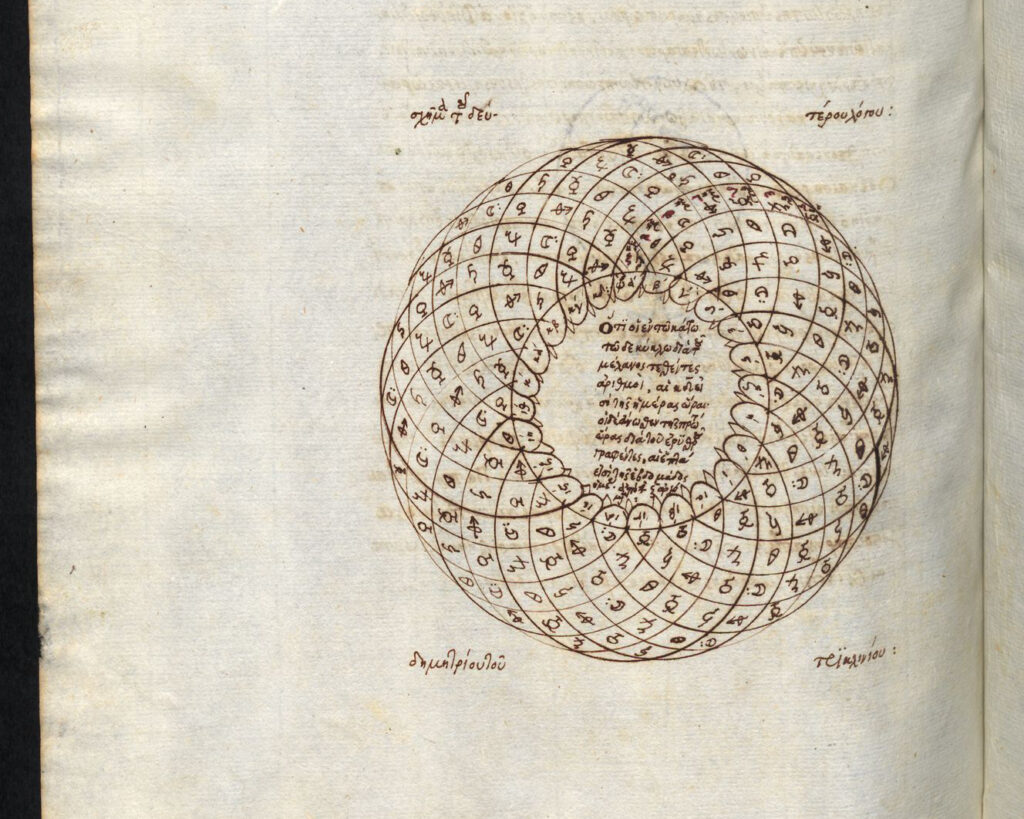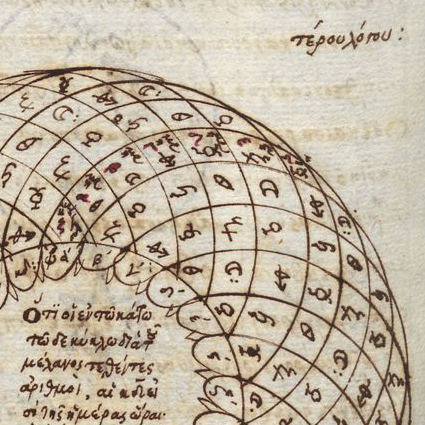The tradition of planetary hours established a ruling planet for each hour of each day. The first hour of the day was ruled by the planet that also gave the day its name, e.g., the sun ruled the first hour of Sunday. Each subsequent hour was ruled by the next planet in the series: Saturn, Jupiter, Mars, Sun, Venus, Mercury, Moon. Planetary hours, like seasonal hours, vary in length throughout the year because they are 1/12th of the daylight or nighttime. Tables of planetary hours are common in early modern texts and printed instruments (e.g., printed sundials). These tables tend to be pretty standard rectangular tables.
When “thumbing” through Ambrosiana C 263 inf., a 16th-century manuscript that contains various astronomical and astrological texts, I came across a pair of rather pleasant tables of planetary hours.
The first looks like some copyist found a spirograph and amused himself by modifying the table:

In the center it describes the table:
Ὅτι οἱ ἐν τῶ κάτω τῶ δὲ κύκλω διὰ τοῦ μέλανος τεθέντες ἀριθμοὶ, αἱ κδʹ εἰσί τῆς ἡμέρας ὥραι. οἱ δὲ ἄνωθεν τῆς πρώτης ὥρας διὰ τοῦ ἐρυθροῦ γραφέντες, αἱ ἑπτά εἰσὶ τῆς ἑβδομάδος ἡμέρες ἀπὸ ♄ ζʹ ἀρχόμεναι. [That the numbers indicated in black in the lower circle are the 24 hours of the day, and those [numbers] written above the first hour in red are the seven days of the week beginning with [Saturn], the seventh.]
Two things to note: First, the table begins with Saturday, but notes it is the seventh day. Second, the careful observer will notice an error in the sixth day, Friday, marked in the outermost ring. It should begin with Venus and the proceed to Mercury, moon, etc. But It begins, instead, with Mercury and then proceeds to the moon.
On the following page there is another circular table of planetary hours.

The text describing the table is nearly identical to the first:
Ὃτι οἱ διὰ τοῦ μέλανος ἔν τε τῶ αʹ καὶ τελευταίω κύκλω τεθέντες ἀριθμοὶ αἱ κδʹ εἰσι τῆς ἡμέρας ὥραι. οἱ δὲ κατ᾽ἐυθεῖαν τῆς αʹ ὥρας διὰ τοῦ ἐρυθροῦ γραφέντες. αἱ ζʹ εἰσὶ τῆς ἑβδομὰδος ἡμέρας ἀπὸ τῆς αʹ ἀρχόμεναι. [That the numbers indicated in black in the first and the last circle are the 24 hours of the day. And those [numbers] written in red in a straight line from the first hour are the seven days of the week, beginning with the first.]
This table begins more typically with Sunday, the first day of the week. And this table does not repeat the error found on the previous page.
